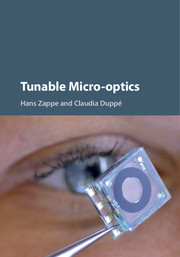Book contents
- Frontmatter
- Dedication
- Contents
- List of contributors
- List of acronyms
- Part I Introduction
- Part II Devices and materials
- 3 Soft-Matter Micro-optics
- 4 Tunable Reflective Optics
- 5 Tunable Liquid Lenses
- 6 Optofluidic Micro-shutters and Micro-irises
- 7 Solid Body Elastomeric Lenses
- 8 Spatially Tunable Polarization Devices
- 9 Aluminum Nitride and Diamond Membranes for Tunable Micro-optics
- 10 Piezoelectrically Actuated Tunable Microlenses
- Part III Systems and Applications
- Index
- References
5 - Tunable Liquid Lenses
from Part II - Devices and materials
Published online by Cambridge University Press: 05 December 2015
- Frontmatter
- Dedication
- Contents
- List of contributors
- List of acronyms
- Part I Introduction
- Part II Devices and materials
- 3 Soft-Matter Micro-optics
- 4 Tunable Reflective Optics
- 5 Tunable Liquid Lenses
- 6 Optofluidic Micro-shutters and Micro-irises
- 7 Solid Body Elastomeric Lenses
- 8 Spatially Tunable Polarization Devices
- 9 Aluminum Nitride and Diamond Membranes for Tunable Micro-optics
- 10 Piezoelectrically Actuated Tunable Microlenses
- Part III Systems and Applications
- Index
- References
Summary
Introduction
Microlenses are used in many applications including optical coupling, light shaping, spatial light illumination modulation, and imaging (biomedical or monitoring). The basic function of a lens is to either diverge or converge the incident light beams. Solid lenses are the most widely used and have a fixed and nontunable focal length. In a solid lens module, voice coil motors (VCMs) are used to provide a back-and-forth track movement along the optical axis to achieve the required focal length change. However, the bulkiness and high power consumption of the lens module make it unsuitable for designing portable and energy saving products. The focal length of liquid lenses can be tuned by changing either the refractive index or the liquid lens geometry. As liquid lenses do not need any mechanical tracking devices such as VCMs for focal length tuning, the lenses provide the optimal solution for developing miniaturized lens modules with low power consumption in the mW range.
In the past two decades, liquid lenses have been widely investigated benefitting from the development of microfluidics (Berge & Peseux 2000, Chang et al. 2012, Chen et al. 2004). In microfluidics, the control or guidance of liquid/analyst droplets is very significant; especially for lab-on-a-chip (LOC) or micro-total analysis systems (μTAS). LOCs are devices that integrate one or several laboratory functions on a small chip of only few square millimeters to a few square centimeters in size, where the manipulation and the guidance of the tiny amounts of liquids or droplets becomes more and more significant. Certain liquid control mechanisms, such as external pressure pumping, electrowetting, and dielectrophoresis, have been developed and widely used for liquid manipulation (Agarwal et al. 2004, Berge & Peseux 2000, Cheng & Yeh 2007). The technique developed for the manipulation of liquids in microfluidics can be used to change the surface profile and the refractive indices of liquid lenses.
A liquid lens refracts the incident light beams based on the presence of the gradient index in liquids or the change in surface profiles formed from the solid (membrane)–liquid, liquid–liquid, and gas–liquid interfaces. The working liquids in the lens chamber must be transparent in the visible range and should be stable for a wide temperature range. To achieve these goals, liquid crystals, water, mixed alcohols, or silicone oil have been used and investigated.
- Type
- Chapter
- Information
- Tunable Micro-optics , pp. 123 - 155Publisher: Cambridge University PressPrint publication year: 2015



